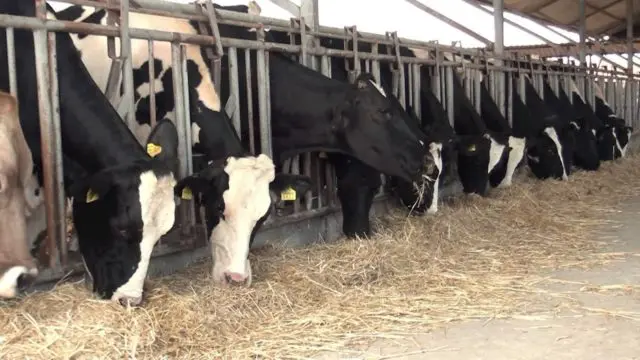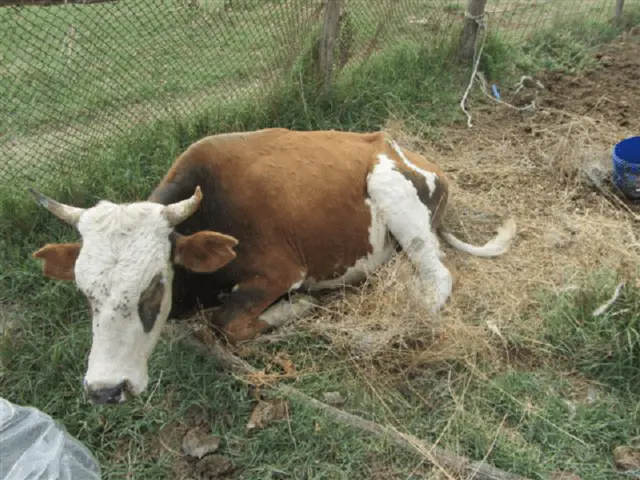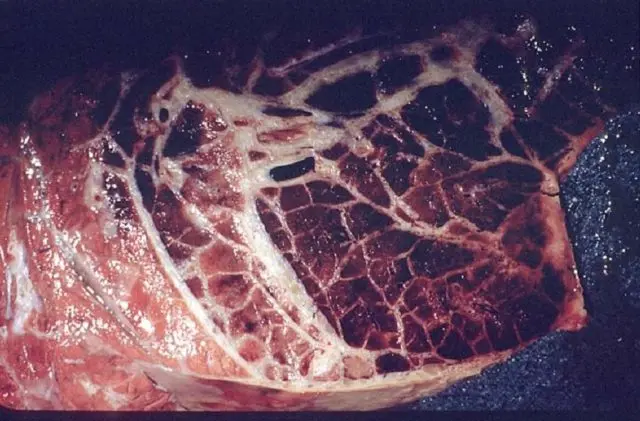Contents
- What is pasteurellosis
- The causative agent of pasteurellosis
- Sources and routes of infection
- Symptoms of pasteurellosis in cows and calves
- Diagnosis of pasteurellosis
- Treatment of pasteurellosis in cattle
- Vaccine against pasteurellosis in cattle
- Pathological and anatomical changes in pasteurellosis in calves and cows
- Preventive measures
- Conclusion
Various diseases of cattle can bring enormous damage to the farm. It is for this reason that the health of pets requires constant monitoring. Among the most dangerous diseases, it is worth highlighting pasteurellosis in cattle, which is also the most common pathology worldwide.

Pasteurellosis, when it enters large farms, can lead to huge losses, consisting in the loss of livestock, as well as considerable costs for treatment.
What is pasteurellosis
Pasteurellosis is an infectious disease that is contagious. It can spread to many domestic and wild animals. The infection quickly penetrates the body, and is also rapidly capable of infecting it. With untimely detection or without the implementation of preventive measures against this disease, a lethal outcome can occur within a day after infection.
The disease affects cattle of any age, but pasteurellosis is considered the most dangerous for young cattle. In calves, immunity is not fully strengthened, so they are more susceptible to pasteurellosis. There is also an increased risk of infection in weakened and unvaccinated cows.
Pasteurellosis is distributed throughout the world. In infected cows, various changes occur throughout the body, the normal activity of internal organs and systems is disrupted. Progressing, the disease leads to the development of such secondary diseases as pneumonia (up to purulent), necrosis of the kidneys and liver, blood poisoning, conjunctivitis and other complications.
The causative agent of pasteurellosis
Pasteurellosis disease is the result of the defeat of the animal by the aerobic bacterium Pasteurella, which is located on the mucous membranes of the gastrointestinal tract. These microorganisms are immobile short oval rods, arranged in pairs or in the form of a chain. When the immunity of the animal is weakened, they enter the bloodstream, spreading throughout the body. As a result, swelling, inflammation and even hemorrhages appear in various organs.
Today, there are 9 types of Pasteurella bacteria, but 2 of them are considered dangerous for cattle:
- multocida;
- haemolytica.
Regardless of the type, the pathogen is characterized by low resistance to various negative external influences. Especially destructive for this bacterium is sunlight and high temperature. Also, many disinfectants are fatal to her.
Sources and routes of infection
Pasteurellosis in cattle is a rapidly spreading disease, the transmission factors of which can be air, feed, water, bedding, various secretions, urine, feces, as well as slaughter products of sick cows. In addition, the pathogen can enter the environment not only from a sick animal, but also from an ill (cured) animal, since the bacterium remains dormant in the body of healthy cows for a long time.

The most vulnerable to pasteurellosis are exhausted cows with reduced immunity.
Pasteurellosis is characterized by seasonality, so most often an outbreak of the disease can be observed in the period from the second half of summer to the end of autumn.
Symptoms of pasteurellosis in cows and calves
Symptoms of pasteurellosis in cattle vary depending on the immune system and age of the animal, as well as the number of bacteria that have entered. Therefore, veterinarians divide the disease into forms, where each has its own symptoms and treatment features.
Acute form
The first signs of cattle infection in acute form of pasteurellosis are the following:
- depression with loss of appetite;
- rapid breathing and heartbeat;
- high temperature, reaching 40 degrees or more;
- lack of milk.
The further development of the disease in an acute course can be divided into 3 more forms, depending on the lesions:
- chest;
- intestinal;
- edematous.
The thoracic form of the development of acute pasteurellosis of cattle is accompanied by the appearance of pleuropneumonia, as a result of which the following are added to the main symptoms:
- discharge from the nasal cavity of purulent exudate;
- labored breathing;
- liquid feces with blood;
- the lungs, when listening, make friction sounds;
- dry strong cough.
In the case of the intestinal form, the following symptoms can be observed:
- strong thirst against the background of a complete loss of appetite;
- rapid weight loss;
- blue mucous membranes.
The edematous form of acute pasteurellosis in cattle is one of the most dangerous, since death can occur within 24-48 hours after the onset of such symptoms:
- cessation of milk formation due to the appearance of severe edema in the udder area;
- the appearance of edema in other parts of the body (genitals, limbs, abdomen, and so on);
- rapid and rather difficult breathing (swelling in the neck);
- asphyxia, which appears due to swelling in the cervical region, which leads to the death of the animal.
Subacute form
The subacute form of pasteurellosis in cattle is slower, the disease can last up to 2 weeks. Symptoms at the initial stage are hardly noticeable, but with the development of the disease, the signs become more pronounced, they include:
- heat;
- hacking cough;
- loss of appetite and weakness;
- strong thirst;
- discharge from the nose, passing from mucous to purulent;
- the appearance of obvious edema in the head and neck;
- tearing and inflammation of the eyes.

The subacute form of pasteurellosis often causes the development of a disease such as enteritis
Super sharp shape
Among all forms of cattle pasteurellosis, the most dangerous is hyperacute, in which an infected individual can die within 12 hours from the end of the incubation period. Due to the rapid development of the disease, it is very difficult to identify, and if it is possible to detect symptoms, then they are of the following nature:
- high temperature exceeding 40 degrees (can reach up to 42);
- the appearance of severe swelling in the neck, chest, as well as internal organs;
- liquid stools with blood impurities.
Chronic form
The chronic form of pasteurellosis is characterized by a longer period of development, reaching 5 weeks. At the same time, the symptoms appear slightly, which is a common cause of the death of cattle, since it can be difficult to recognize the signs of the disease in time.
Among the obvious symptoms that you should definitely pay attention to are:
- breathing, which may be difficult;
- refusal to eat, which leads to rapid weight loss;
- swelling of the joints of the extremities;
- the appearance of diarrhea with blood impurities.
Diagnosis of pasteurellosis
Pasteurellosis is an infectious disease, at the slightest sign of which timely testing is required. In live cattle, diagnosis is carried out by examining mucus from the nasal cavity and a blood test. The withdrawn smears are examined in detail in the laboratory under a microscope, and bakposev is also carried out. In some cases, they even perform a special treatment of rodents to determine the degree of virulence of the pathogen. After determining the desired results, the selection of the required adequate treatment is carried out.
In the case of a pestilence of cattle, diagnosis is carried out by laboratory or post-mortem examination.
When conducting a laboratory study, samples taken no later than 5 hours from cows after slaughter or spontaneous death are used. As a sample, particles of such internal organs as the liver, spleen, lungs or lymph nodes can be used. The detected pathogen is placed in a nutrient medium, after which its belonging is revealed.
In a pathoanatomical study, the possibility of infection with pasteurellosis is detected on the basis of changes in internal organs and life support systems. The following signs indicate a positive result:
- hemorrhage in the internal organs (in the heart, lungs, intestines);
- the presence of accumulation of blood and lymph under the skin in the fiber;
- lymph nodes are enlarged;
- inflammation of various parts of the gastrointestinal tract.

Timely and correct diagnosis of pasteurellosis is the basis of its successful treatment.
Treatment of pasteurellosis in cattle
If characteristic signs of pasteurellosis are found in any individual of cattle, the cow is immediately isolated from other domestic animals. It is determined in a dry, warm room with good ventilation. In this case, the animal is transferred to a special diet with the addition of vitamins, minerals and other nutrients to improve well-being. If the disease is detected at an early stage, then the developed serum against cattle pasteurellosis is used to combat it. With a later detection, this drug is ineffective, so a number of other drugs are prescribed.
After conducting the necessary research to identify the disease and its form, determine the appropriate medical course of treatment, which is carried out in two directions:
- symptomatic treatment – a sick animal is given drugs that improve the functioning of internal organs and the life support system;
- specific therapy – the cow is injected with drugs against a developing infection.
In addition, they also conduct a course of antibiotics, which help to eliminate inflammatory processes in the body and suppress the causative agent of pasteurellosis.
The treatment itself is carried out until the complete recovery of the animal. At the same time, the recovered individual retains immunity to pasteurellosis for approximately 6-12 months.
Vaccine against pasteurellosis in cattle
Emulsified vaccine against pasteurellosis in cattle is the most effective protection for livestock. A specially developed preparation contains an emulsion and an emulsifier, thanks to which the animal acquires temporary immunity against the disease. The period of its preservation can reach from six months to a year.
The vaccine is administered intramuscularly in the region of the middle third of the neck. The dosage must be determined by the veterinarian.
For infertile and pregnant cows, a single injection of the emulsion is suggested 25-45 days before calving. Calves are vaccinated once in the case of vaccinated parents on the 20th-25th day of life, and twice on the 8th-12th day with a repeat on the 15th-21st day with unvaccinated parents.
Pathological and anatomical changes in pasteurellosis in calves and cows
Pathological and anatomical changes in the internal organs with pasteurellosis in calves and cows directly depend on the form of this disease. Thus, in the acute or hyperacute course of the disease, multiple bruises and hemorrhages in the area of the liver and heart can be observed. But the presence of inflammation in the lungs, swelling of many internal organs and necrosis of the kidneys or liver is a consequence of the chronic form of pasteurellosis.
An example of changes in internal organs with pasteurellosis in cattle can be seen in the photo below.

Cow lung with thoracic pasteurellosis (croupous pneumonia)
Preventive measures
In addition to timely vaccination of cattle, an important step in the fight against pasteurellosis is the following preventive measures:
- keeping livestock according to all sanitary and hygienic requirements;
- ensuring proper and balanced nutrition (constant monitoring of feed quality);
- periodic disinfection of feeders, premises for keeping livestock, as well as related care equipment;
- availability of special clothes for working on the farm (including an individual set for each worker);
- the acquisition of new livestock only in prosperous, proven farms;
- exposure of newly acquired cattle for a month separately from the entire herd (if necessary, vaccination).
If, nevertheless, the disease could not be avoided, and it has become widespread, the owner of the herd should immediately contact the sanitary and epidemiological service of the district to combat the infection and prevent its further spread to nearby farms.
Conclusion
Pasteurellosis in cattle is a very dangerous infection that requires timely detection and treatment. At the same time, it is advisable not to waste time on long-term observation when the first symptoms are detected, but to immediately contact a veterinarian to establish a final diagnosis.









